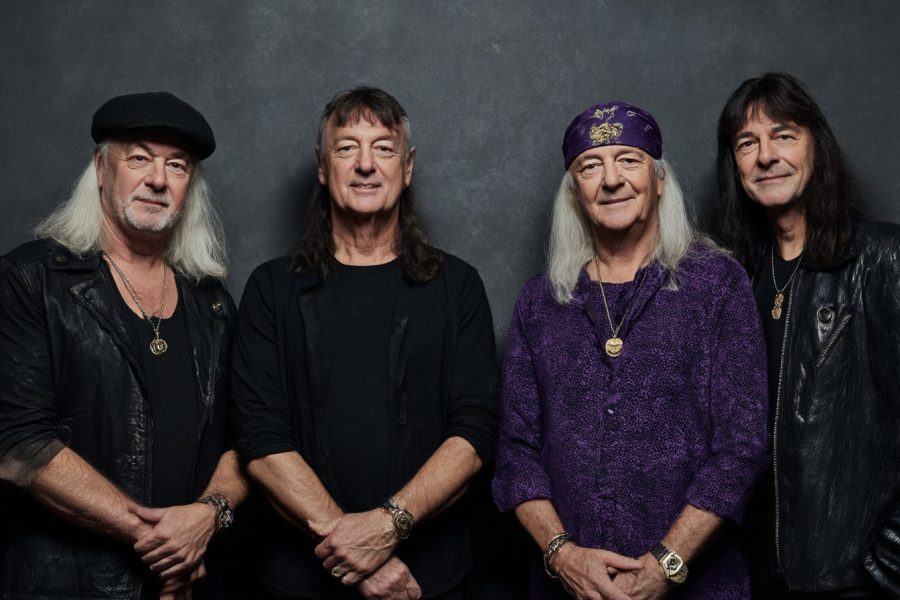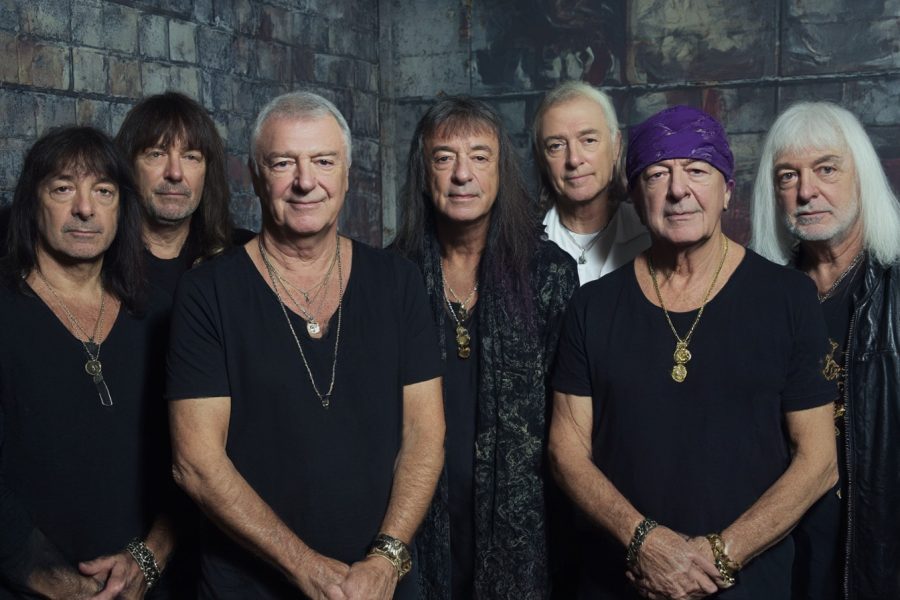I was 13 years old when I stole—okay, “indefinitely borrowed”—my older brother’s copy of Deep Purple’s “Machine Head.” This was 1984, and I was deep in the throes of my early metal obsession. Maiden, Priest, early Metallica. My brother Keith had largely abandoned his 70s rock collection as he’d moved on to whatever synthesizer-driven nonsense was trendy in college dorms that year. His loss, my gain.
I’d spin that record constantly, to the point where my mom would bang on my bedroom door and threaten increasingly creative punishments if I played “Highway Star” one more time that day. That album was my gateway drug to the larger Deep Purple catalog—”In Rock,” “Fireball,” “Made in Japan.” I worked backward through their discography with the methodical dedication that only a teenage boy with no social life can muster.
So when rumors started swirling that the classic Mark II lineup—Gillan, Blackmore, Glover, Lord, and Paice—was reuniting, I was skeptical but intrigued. Reunions in rock have a notoriously spotty track record. For every successful second act, there are a dozen embarrassing cash grabs where formerly vital musicians trudge through pale imitations of their glory days. And Deep Purple’s breakup hadn’t exactly been amicable—the bad blood between Gillan and Blackmore was legendary, their personalities like matter and antimatter. Getting them in the same room seemed ambitious; expecting them to recapture the magic of “Machine Head” seemed delusional.
I remember standing in Tower Records in November of ’84, holding “Perfect Strangers” in my hands like it might explode. The cover didn’t inspire confidence—that generic purple cosmic background looked like something from a mall poster kiosk. But I handed over my $8.99 anyway. Worst case scenario, it’d just be another disappointment to add to the pile of mediocre reunion albums.
I still remember dropping the needle on side one and hearing that keyboard intro to “Knocking at Your Back Door.” My first thought was, “Well, that’s definitely Jon Lord.” His Hammond organ sound was unmistakable, as distinctive as a fingerprint. Then Paice’s drums kicked in with that controlled power that always made him one of rock’s most underrated timekeepers. But it was when Blackmore’s guitar entered—that crystalline, slightly medieval-tinged phrasing—that I sat up straight. The hair on my arms literally stood up. Holy shit. They were actually back.
By the time Gillan started singing, I was fully converted. His voice had matured, sure—a bit rougher around the edges than in ’72—but that just added character. He wasn’t trying to pretend he was still 27 years old, but he wasn’t embarrassing himself either. He’d found that sweet spot that eludes so many aging rock vocalists: acknowledging the passage of time while still delivering the goods.
“Perfect Strangers” wasn’t Deep Purple trying to make “Machine Head Part II,” and that was its genius. This wasn’t a band awkwardly trying to recapture their youth; this was five master musicians picking up a conversation they’d left unfinished a decade earlier. The material respected their legacy without being imprisoned by it.
Take the title track—that middle-eastern tinged riff, the atmospheric keyboards, Gillan’s philosophical lyrics. This wasn’t “Smoke on the Water” or “Space Truckin’.” It was recognizably Purple but evolved, like running into an old friend who’s somehow improved with age instead of just gotten older.
The production struck me immediately too. Roger Glover pulling double duty as bassist and producer gave the album a clarity and punch that perfectly captured the band’s power without sounding dated. In an era when most rock productions were drowning in gated reverb and electronic drums, “Perfect Strangers” sounded refreshingly organic and muscular. You could hear the air moving through Lord’s Leslie speakers, feel the wood of Blackmore’s Stratocaster.
I played that album so relentlessly that winter that I had to replace it by spring—the vinyl literally worn out from repeated plays. My favorite track shifted weekly. Initially, it was the title track, then “Knocking at Your Back Door.” Eventually, I settled on “A Gypsy’s Kiss” as the album’s hidden gem, with its perfect showcase of the Blackmore/Lord interplay that had always been the band’s secret weapon.
Years later, I had the chance to interview Roger Glover for a retrospective piece, and I asked him how they managed to avoid the reunion album curse. He laughed and said, “Low expectations are a gift. Everyone assumed we’d kill each other or release something terrible. When you’re expected to fail, there’s a strange freedom in that.” He also revealed something I found fascinating—they deliberately avoided listening to their old albums during the writing process. “We wanted to sound like ourselves without copying ourselves, if that makes sense.”
It made perfect sense. “Perfect Strangers” succeeds precisely because it’s not trying to be “Machine Head” or “In Rock.” It’s the sound of five musicians acknowledging their shared history while creating something new. The interplay between Blackmore and Lord remained the band’s core, but there was a maturity to it now—less about individual showmanship and more about serving the songs.
Not that the album is without showmanship. “Son of Alerik” (originally just on the cassette and CD versions, later added to reissues of the vinyl) is essentially a Blackmore showcase, allowing him to stretch out with the fluid, neoclassical touches that had always set him apart from his contemporaries. And Lord’s organ work throughout is a masterclass in how to be technically brilliant without descending into pointless noodling.
Lyrically, there’s a self-awareness that adds another dimension to the album. When Gillan sings “I don’t need to come back yesterday” in “Nobody’s Home,” it’s hard not to hear it as a statement of intent for the reunion itself. This wasn’t a nostalgia exercise; this was Deep Purple establishing that they still had something to say in 1984.
The album’s commercial success—it went gold in the US and returned the band to arenas worldwide—validated what fans like me already knew: when firing on all cylinders, there was still no band quite like Deep Purple. The combination of classical virtuosity, hard rock power, and blues-based improvisation remained unique in the rock landscape.
I caught them on the Perfect Strangers tour when they came through Los Angeles—my first time seeing the classic lineup live. I’d seen the Coverdale/Hughes version years earlier (a story for another day), but this was different. This was the lineup from those albums I’d worn out in my bedroom. I remember being struck by how genuinely engaged they seemed—there was none of that going-through-the-motions quality you often get with reunion tours. Blackmore was still the mercurial figure stage left, turning his back to the audience during solos, while Gillan worked the stage with the confidence of someone who knew he didn’t have to prove anything to anyone. They played a good mix of classics and new material, and tellingly, the songs from “Perfect Strangers” didn’t feel out of place alongside “Highway Star” or “Smoke on the Water.”
Of course, the reunion didn’t last forever—Blackmore’s prickly nature and Gillan’s equally strong personality ensured that. But for a few years there, Deep Purple’s second act was as compelling as their first. “Perfect Strangers” stands as proof that sometimes lightning can strike twice. The album has aged remarkably well, largely because it never tried to chase contemporary trends. While other 70s bands were awkwardly incorporating synthesizers and drum machines to sound “current” in the 80s, Purple simply sounded like Purple, only with better production and the wisdom that comes with age.
I still put on “Perfect Strangers” regularly—now on vinyl again, having come full circle in my music consumption habits. What strikes me most is how it manages to be both a perfect entry point for new fans and a satisfying chapter for those who’d been there from the beginning. It’s an album that respects the band’s legacy without being handcuffed by it.
The greatest compliment I can pay “Perfect Strangers” is this: if you’d never heard Deep Purple before and started with this album rather than their 70s classics, you wouldn’t feel like you were getting a diminished version of the band. You’d be experiencing them at a different stage of their evolution, certainly, but not a lesser one. How many reunion albums can honestly make that claim?
In a career defined by lineup changes and stylistic detours, “Perfect Strangers” stands as one of Deep Purple’s finest moments—proof that sometimes the sequel can be every bit as good as the original, even if it tells a slightly different story. Not bad for a bunch of rock dinosaurs who everyone had written off as extinct.

